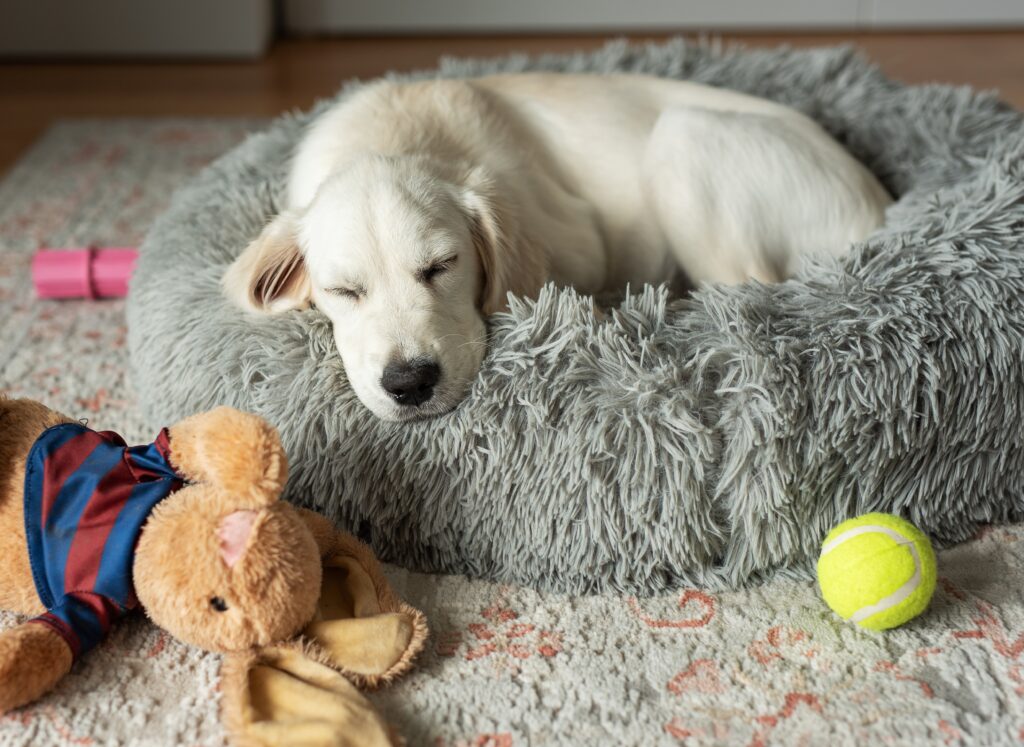The best spot for a puppy to sleep at night should be a safe, quiet, and comfortable area where they feel secure, and where you can easily monitor them.
Here are some key considerations for choosing the ideal sleeping spot for your new puppy…
Crate or Playpen (Recommended)
- Crate Training – A crate is one of the best places for a puppy to sleep, especially during the first few months. It creates a small, cozy space that mimics a den-like environment. This helps your puppy feel safe and secure.
- Benefits of a Crate
- Safety – It prevents accidents in the house while you’re not awake to supervise.
- Comfort – Many puppies naturally enjoy their crate as a resting area once they are crate-trained. It provides a sense of personal space and security.
- Housebreaking – A crate helps with housebreaking since puppies tend to avoid soiling their sleeping area.
- Location for the Crate – Place the crate in a quiet part of the house, ideally near your bedroom (so your puppy doesn’t feel isolated). Puppies often feel more secure when they can hear or smell you.
Near Your Bedroom (If Crate Training)
- Why Near Your Room? – Having your puppy sleep in your bedroom, or nearby, helps them feel more secure as they can hear and smell you. It also minimizes anxiety during the night, as puppies often feel lonely in unfamiliar environments.
- Gradual Transition – If you want the puppy to eventually sleep alone in another room, you can gradually transition them by moving the crate further away each week.
Bed or Blanket Area
- Some owners choose to let their puppy sleep on a soft bed or blanket in a designated sleeping area (often next to the bed or in a puppy-safe space). This can make house training more challenging since puppies may not associate their sleeping area with keeping it clean. It’s best to reserve this option for once they’re house-trained and reliably going outside.
Avoid Sleeping in Your Bed (Initially)
- While it’s tempting to let your puppy sleep in your bed, this can lead to behavioral issues like separation anxiety and difficulty establishing boundaries. It can also make housebreaking more difficult, as puppies may struggle with potty training if they have easy access to the bed during the night.
Consider Your Puppy’s Size and Breed
- Small Breeds – Small puppies or breeds may feel more comfortable in smaller crates or cozy spaces, where they can feel more secure and relaxed.
- Large Breeds – Larger puppies may need bigger crates or spaces, and they might require more room to stretch out. Ensure the crate is large enough for them to turn around comfortably but not too large, or they might start using part of it as a bathroom.
Temperature and Comfort
- Soft Bedding – Use soft bedding or blankets to make the sleeping spot cozy. Avoid overly thick bedding that might cause overheating or make it harder for the puppy to move around.
- Temperature Control – Make sure the area isn’t too hot or cold. Puppies, especially young ones, can get cold easily, so a draft-free area is ideal.
Avoid High-Traffic Areas
- While it’s great to have the puppy close, avoid placing their sleeping area in high-traffic or noisy areas of the house. The constant movement and sounds may disturb their sleep. Choose a relatively quiet spot where they won’t be constantly disturbed.
The best spot for a puppy to sleep at night is usually a crate placed in a quiet, safe area near your bedroom. This provides comfort, security, and helps with house training. Once your puppy is older and more housebroken, you can consider alternative sleeping arrangements, but starting with crate training is generally the most effective way to set your puppy up for success.


